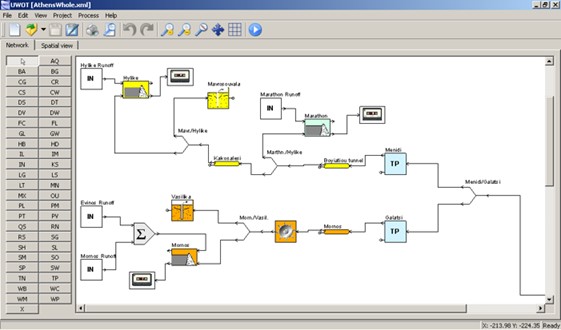The Urban Water Optioneering Tool (UWOT) is a model that simulates the generation and routing of urban water demands to facilitate the planning and assessment of distributed interventions at multiple scales in the urban water cycle. The planning and assessment is based on various metrics estimated by UWOT, such as potable water demand, runoff volume and required energy.
What it does
UWOT is a model that simulates urban water demands, to allow for optimal planning and assessment of distributed interventions in the urban water cycle. Unlike other urban water cycle models, which simulate urban flows, UWOT uses a bottom-up approach to simulate the generation and routing of the water demand signals that start from the demand point (i.e. the consumer’s tap) and are propagated all the way up to water sources (such as regional reservoirs) suitably translated, transformed and aggregated passing through the water infrastructure (distribution networks, supply networks, tanks and reservoirs). The use of a single model to simulate supply (reservoirs, aqueducts), distribution and consumption (end users), as well sewerage, drainage, WWTP and recipient waters is important as it allows options of reuse, synergies between flows as well as synergies with other infrastructure (energy) to be explored. The focus on demand signals is closely related to social behaviour, hence makes it easier to integrate UWOT with social simulation models (such as Agent Based Models). It can therefore account for a major part of a full socio-technical system at multiple scales.

An example of a UWOT model at the household level
Within UWOT the modeller can design and evaluate alternative water system configurations at multiple scales (from the household, all the way up to the regional water system). This configuration takes advantage of the drag and drop interface of UWOT as well as its extensive technology library. In the example shown in the figure below, a household network is created that includes a rainwater harvesting scheme and a local treatment unit, both installed to reduce potable water demand. The harvested rainwater along with the treated greywater (from the shower, bath and sink) is stored in a local tank and used for toilet flushing, the washing machine and outdoor uses. The rest of the appliances are supplied only with potable water from water mains. Mains water is also used to ensure that the stored water in the local tank does not drop below a minimum level. The inputs used during the simulation include time series of rainwater, temperature, frequency of use, and occupancy. After the simulation, the users can assess the performance of the intervention. For example, they can inspect the fluctuation of the stored water inside the water tank. If the tank overflows frequently, then either a larger tank or a smaller local treatment unit are required. If the tank is frequently empty, then either a larger local treatment unit or a larger rainwater harvesting area should be employed. The users can also examine potable water demand, runoff and wastewater volumes. Furthermore, they can check the energy required by the water infrastructure and technologies and also quantify the energy absorbed by green areas due to evaporative cooling – hence calculating additional ecosystem services that result from irrigation with non-potable water. The figure to the right is an example of a UWOT configuration of an external raw water supply system.

Downloads
Download an educational version of UWOT and relevant tutorial files
Relevant publications
- Bouziotas, D., Stofberg, S., Frijns, J., Nikolopoulos, D., Makropoulos, C., 2023. Assessing the resilience of circularity in water management: a modeling framework to redesign and stress-test regional systems under uncertainty. Urban Water Journal 20, 532–549. https://doi.org/10.1080/1573062X.2023.2190030
- Makropoulos, C., Bouziotas, D., 2023. Artificial intelligence for decentralized water systems: A smart planning agent based on reinforcement learning for off-grid camp water infrastructures. Journal of Hydroinformatics 25, 912–926. https://doi.org/10.2166/hydro.2023.168
- Nikolopoulos, D., Kossieris, P., Tsoukalas, I., Makropoulos, C., 2022. Stress-testing framework for urban water systems: A source to tap approach for stochastic resilience assessment. Water 14, 154. https://doi.org/10.3390/w14020154
- Bouziotas, D., van Duuren, D., van Alphen, H.J., Frijns, J., Nikolopoulos, D. and Makropoulos, C., 2019. Towards circular water neighborhoods: Simulation-based decision support for integrated decentralized urban water systems. Water, 11(6), p.1227.
- Rozos, E., C. Makropoulos, and C. Maksimovic, Rethinking urban areas: an example of an integrated blue-green approach, Water Science and Technology: Water Supply, 13 (6), 1534-1542, doi:10.2166/ws.2013.140, 2013.
- Rozos, E., and C. Makropoulos, Source to tap urban water cycle modelling, Environmental Modelling and Software, 41, 139-150, doi:10.1016/j.envsoft.2012.11.015, Elsevier, 1 March 2013.
- Rozos, E., and C. Makropoulos, Assessing the combined benefits of water recycling technologies by modelling the total urban water cycle, Urban Water Journal, 9 (1), doi:10.1080/1573062X.2011.630096, February 2012.
- Rozos, E., C. Makropoulos, and D. Butler, Design robustness of local water-recycling schemes, Journal of Water Resources Planning and Management – ASCE, 136 (5), 531-538, doi:/10.1061/(ASCE)WR.19, 2010.
- Makropoulos, C. K., Natsis, K., Liu, S., Mittas, K., and D. Butler, Decision support for sustainable option selection in integrated urban water management, Environ. Modell. Software 23(12), 1448-1460, 2008.


